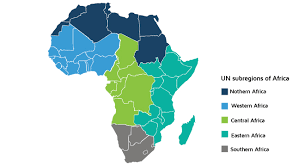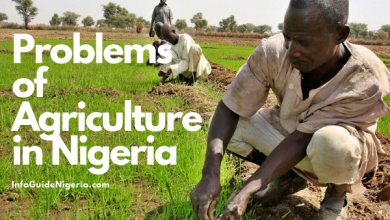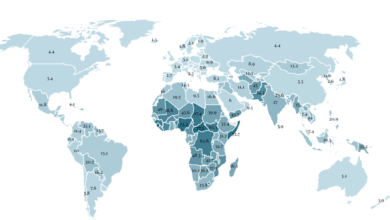
Top 10 Countries with high malnutrition rates in Africa
Malnutrition remains one of the biggest challenges facing the African continent today. While progress has been made in reducing hunger and malnutrition rates over the past few decades, many countries still grapple with staggeringly high rates of malnutrition, especially among children under 5 years old. This article takes a closer look at the top 10 African countries with the highest rates of malnutrition.InformationGuideNigeria
The top 10 Countries with high malnutrition rates in Africa:
1. Central African Republic
The Central African Republic (CAR) has the dubious distinction of having the highest rate of malnutrition globally. According to 2019 data from UNICEF, about 61.8% of children under 5 in the CAR suffer from stunting as a result of chronic malnutrition. The crisis in the CAR stems from years of political instability and conflict which destroyed livelihoods and disrupted food production and supply chains. With over half its population needing humanitarian assistance, the CAR’s malnutrition crisis shows no signs of abating soon.
👉 Relocate to Canada Today!
Live, Study and Work in Canada. No Payment is Required! Hurry Now click here to Apply >> Immigrate to CanadaRead Also: Top 10 Countries with high illiteracy rates in the World
2. Madagascar
Madagascar, an island nation off the southeastern coast of Africa, has a malnutrition rate of 49% as of 2020. This gave it the fourth highest rate globally according to WHO data. Stunting affects almost half of children under 5 while wasting, usually the result of acute malnutrition, impacts 6.1% of under 5’s. Contributing factors include high poverty levels, frequent droughts and cyclones which negatively affect food security, low dietary diversity, and poor access to clean water and sanitation facilities. Successive governments have failed to make significant investments in nutrition interventions.Top 10 Countries with high malnutrition rates in Africa
3. Democratic Republic of Congo
The Democratic Republic of Congo (DRC) has struggled with high rates of malnutrition for decades. Current statistics indicate 40.4% of Congolese children under 5 are stunted. Low agricultural productivity, political instability, disease outbreaks, food insecurity, poverty, and limited access to healthcare and dietary diversity all fuel malnutrition in the DRC. Stunting rates vary across the country but are highest in conflict-ridden areas like Kasai, Tanganyika, and South Kivu. Malnutrition not only harms physical growth and cognitive development but also increases susceptibility to diseases like diarrhea.Top 15 Best-Selling Apple Products in Nigeria
4. Yemen
Yemen’s ongoing humanitarian crisis has left millions suffering from starvation. About 39% of children under 5 were stunted even before the conflict escalated in 2015. Today, over 2 million children are acutely malnourished. The crisis stems from the civil war which has destroyed infrastructure, disrupted livelihoods, displaced families, and led to food shortages. Lack of access to healthcare amid the conflict further compounds malnutrition. UNICEF estimates 400,000 Yemeni children suffer from severe acute malnutrition and could die without treatment. But with the economy in ruins, most Yemenis can’t afford food or treatment.
Read Also: Top 10 Highest Oil Producing Countries in Africa
5. Somalia
Somalia has suffered from recurrent droughts, floods, conflict, and food insecurity, creating an acute malnutrition crisis. As of 2020, 38.7% of children under 5 were stunted while 12% suffered from wasting due to acute malnutrition. While malnutrition has dropped slightly over the last decade, rates remain worryingly high, especially within displaced communities and arid northern regions. Contributing factors include low rates of exclusive breastfeeding, frequent infections, low dietary diversity, and lack of access to clean water. Government instability also hampers the provision of nutrition interventions and healthcare access.
6. Zimbabwe
Zimbabwe’s economic troubles over the last decades have significantly increased malnutrition rates. According to 2019 government statistics, stunting affects 26.6% of children under 5 while another 3.3% suffer from wasting. Rural areas which depend on agriculture are worst affected, exacerbated by recurrent droughts and floods. Zimbabwe’s hyperinflation often leaves poor households unable to afford nutritious foods. Lack of dietary diversity, low immunity, frequent infections, and lack of access to clean water and sanitation facilities also fuel malnutrition. Social safety nets and nutrition programs reach few families, leaving many Zimbabwean children at risk.15 Best Apple Gadgets in the Nigerian market
Read Also: Top 15 Low-income Countries in Africa
👉 Relocate to Canada Today!
Live, Study and Work in Canada. No Payment is Required! Hurry Now click here to Apply >> Immigrate to Canada7. Chad
44.6% of Chad’s children under 5 suffered from stunting in 2020 according to UNICEF. Chad suffers from chronic food insecurity, exacerbated by environmental degradation, poverty, and internal displacement of people due to conflict. Refugees from neighboring countries also strain Chad’s resources. Diets lack diversity, relying heavily on staples like cereals, roots, and tubers. Less than 20% of households have access to safe drinking water or sanitation. A weak healthcare system hampers the delivery of nutrition interventions. Government spending on healthcare remains one of the lowest globally.105 Good Morning My Love Messages
8. Eritrea
Eritrea’s malnutrition crisis is tied to its history of conflict, recurrent droughts, and authoritarian government policies. 39.8 percent of Eritrean children were stunted in 2020 according to government data. Wasting affected 9.9 percent of children nationally but over 20 percent in some regions. Contributing factors include low dietary diversity, with people relying predominantly on cereals, tubers, and pulses. Only 20 percent of Eritreans have access to basic sanitation facilities. National nutrition policies and programs are inadequate. The heavy-handed Eritrean government also limits access to humanitarian agencies seeking to address malnutrition.JAMB Portal
Read Also: Top 15 Countries with Substantial Fishing Resources
9. Burundi
Burundi has the world’s highest prevalence of chronic malnutrition according to the World Food Programme. Stunting affected 39.3% of under 5’s in 2020 while wasting impacted 2.7%. Burundi has struggled to recover from a devastating civil war between 1993-2005. Ongoing poverty and food insecurity are major contributors. Natural disasters like droughts and floods frequently threaten livelihoods. Diets rely heavily on banana and tuber crops, lacking protein and micronutrient-rich foods. Less than 30% of Burundians have access to basic drinking water and sanitation services. Healthcare and nutrition interventions reach just a fraction of the population needing support.200 Romantic Message for Her
10. South Sudan
After gaining independence in 2011, conflict erupted in the world’s newest nation just two years later. The civil war caused widespread displacement, loss of livelihoods, and severe food insecurity. Today malnutrition plagues an estimated 39.2% of children under 5. However, some areas report malnutrition rates above 70 percent, especially in displacement camps. Diets are largely grain and tuber-based, with minimal protein intake. Flooding during the rainy season isolates communities while drought hurts crops. Over 60 percent of South Sudanese lack access to safe water and sanitation. Significant investment in food security, health, nutrition, and livelihoods is critically needed.NYSC Portal
Read Also: Top 15 States with High Poverty Rates in Nigeria
Conclusion
African nations should tackle malnutrition as a top priority. The human and economic costs stagger. While some countries have made progress, rates remain far too high, condemning millions of children to stunted growth and impaired cognition. By addressing root causes – poverty, food insecurity, lack of access to healthcare, poor water and sanitation, and boosting local agricultural production – nations can combat malnutrition. Investing in nutrition programs, health services, education, and sustainable development stands as vital. With targeted interventions, adequate resources, and political will, nations can reduce malnutrition rates, creating a healthier, more prosperous future for Africa. But Africa urgently needs greater action to help give every African child the nutrition required to thrive.
Check: JAMB Result
Check and Confirm: How Much is Dollar to Naira








